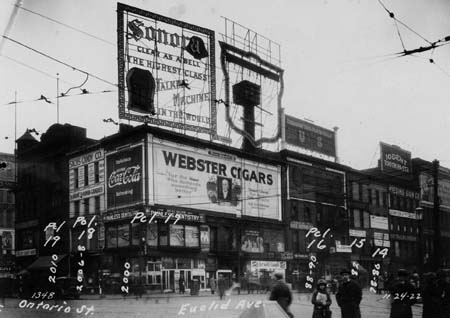Cleveland's Terminal Tower -
The Van Sweringens' Afterthought
The Terminal Tower, imposing architectural center and symbol of
the City of Cleveland, actually came into being as last minute
addition to a train station that was years in the planning, but
that is itself now abandoned and largely forgotten.
In 1910 a visitor to Cleveland would almost certainly have come
by train. If he had traveled from Washington or Kansas City, he
would have bought his ticket at the new union station in one of
these cities. 1
But when he arrived in Cleveland, he might have gotten off in
any of fifteen locations, depending on which railroad he patronized.
If he had taken the New York Central, he could have gotten off
at the old lake front station, located at the foot of West Sixth
Street, from where he could have walked to Public Square, the
hub of Cleveland trolley lines, to catch a streetcar to his destination
in the city. Or he could have taken an interurban -- a self-propelled
electrified railway car -- to any number of cities in northeastern
Ohio beyond. At that time Ohio had one of the most extensive interurban
networks, with over 2000 miles of track. Before automobiles became
common, the interurbans provided short- to medium- distance transportation,
hauling freight as well as passengers. They were the forerunners
of today's bus and truck lines. 2

|
| The southwest corner of Euclid Avenue and Ontario Street as it appeared in 1922, before demolition for new construction. The site is now occupied by the Higbee Company, part of the Van Sweringens' efforts to create a high-density development. The writing on the photograph indicates land parcels that the Van Sweringen interests were acquiring. Photo: Gerald Adams collection.
|
Where Cleveland's Terminal Tower complex now stands were dilapidated
old buildings covered with rust, soot and advertising, which bore
witness to Cleveland's first mercantile age. Once considered a
beautiful corner of the city, the southwest quadrant of Public
Square and lower Superior Avenue had experienced a continual decline
in real estate values, as business enterprises moved to newer
and more modern buildings located to the east -- strung out along
Euclid Avenue. Public Square was no longer the center of gravity
of Cleveland's business or financial community. On the north side
of the Square was located the Old Stone Church (1855) and the
medieval-revival Society for Savings Bank (1889). On the east
side was the new Federal Building (under construction), the pioneering
but plain Cuyahoga Building (1893), and the Williamson Building
(1900). 3
(In spite of vigorous objections, these last two were demolished
in 1982 to make way for the Sohio headquarters.)
In the southeast quadrant could be found the Cuyahoga County Soldiers'
and Sailors' Monument, the siting of which caused considerable
controversy in the late 1880's. 4
It was originally to have been located in the middle of Public
Square, at the present junction of Superior Avenue and Ontario
Street. But the streetcar companies gained control of these streets
for the placement of their tracks, and thus deprived the Monument
of a central location, though Public Square's function as an important
transportation node was reinforced by this outcome. The controversy
then shifted to the appropriateness of the southeast quadrant.
Judge Samuel E. Williamson, the owner of a property on the corner
of Euclid Avenue and Public Square, in a letter to the City's
Park Commissioners (October 3, 1887), expressed the fear that,
because of the size of the Monument, his property would no longer
front on a park, but on a street, thus decreasing its value, and
that the Monument would completely obscure the view from Euclid
Avenue across the Square. Furthermore, (important for the Terminal
Tower project 35 years later) he questioned the City's legal right
to permit the erection of a building not to be under city control,
and not to be used for strictly public purpose, on city property,
It took an Act (passed in 1888) of the Ohio Assembly to make the
use of the south-east quadrant legal for the Monument's location.
Continues in: A "City Beautiful" mall for Cleveland
Table of Contents
